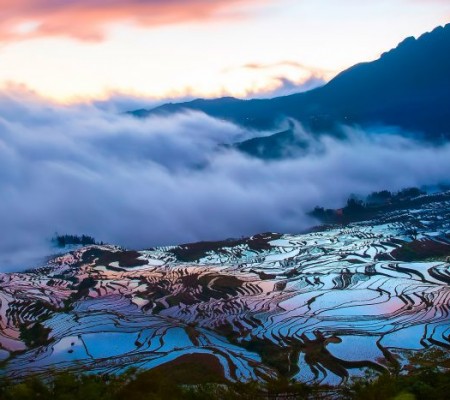
Pattra-leaf Scriptures Making Craft of Dai Ethnic Minority in Xishuangbanna
The art of making palm-leaf manuscripts (贝叶经制作技艺) is a traditional craft originating from Xishuangbanna (西双版纳), Yunnan Province, China. Recognized as one of China’s National Intangible Cultural Heritage items, this ancient technique involves engraving Buddhist scriptures onto specially treated leaves of the Corypha umbraculifera palm tree (贝叶棕), known as “Guo Lan” (郭懒) in the Dai language.
Cultural Significance
Known as “Tan Lan” (坦懒) in the Dai language, these palm-leaf manuscripts represent a sacred medium for preserving Theravada Buddhist scriptures. Through a series of traditional processing methods, the palm leaves become resistant to insects, water, and deformation, allowing the manuscripts to survive for centuries.
Production Process
The manuscripts are created by engraving text onto prepared palm leaves (“Ge Lan” or 戈兰) using a stylus crafted by local artisans. This intricate process involves:
- Harvesting and treating palm leaves
- Cutting and preparing writing surfaces
- Engraving text with specialized metal tools
- Applying natural preservatives
Preservation Status
In 2008, this traditional craft was officially listed in:
- China’s Second National Intangible Cultural Heritage List
- Approved by the State Council of the People’s Republic of China
- Heritage Item Number: VIII-142
The art of palm-leaf manuscript making continues to be practiced by Dai ethnic artisans, preserving an important aspect of Southeast Asian Buddhist culture and traditional book-making techniques.
Historical Origins
The palm-leaf manuscript tradition (贝叶经) first originated in India and was introduced to the Dai-inhabited regions of Yunnan around the 7th century, where it flourished and developed.
Beyond recording Buddhist scriptures, Dai palm-leaf manuscripts encompass a wide range of content including:
- Astronomy and calendrical systems
- Social history
- Philosophy
- Legal codes
- Medical knowledge
- Scientific and technological achievements
Regarded as the “encyclopedia” of Dai culture, these manuscripts play a vital role in the production and daily life of the Dai people and are treasured as invaluable cultural assets.
Preservation and Transmission
Most Dai Buddhist temples maintain dedicated scripture halls to preserve these manuscripts. According to folk tradition:
- Ancient palm-leaf manuscripts numbered over 80,000 volumes
- Xishuangbanna (西双版纳) has collected more than 3,000 volumes
- Numerous manuscripts remain scattered among local communities
Linguistic and Religious Context
Known as “Tan Lan” (坦兰) in the Dai language, these manuscripts represent the canonical texts of Theravada Buddhism (南传上座部佛教).
Transmission Route
The palm-leaf manuscript tradition:
- Originated in India
- Spread to Sri Lanka with Theravada Buddhism around the 7th century CE
- Was subsequently transmitted through Myanmar and Thailand
- Finally reached the southwestern frontier regions of China’s Yunnan Province
This cultural transmission route reflects the historical exchanges along the Southern Silk Road and the spread of Buddhist civilization across Southeast Asia.
Technical Characteristics
Palm-leaf manuscripts exhibit unique craftsmanship features:
- Format Flexibility
The engraved content is not constrained by fixed specifications, allowing for adaptable layouts. - Decorative Finishing
Manuscript edges are traditionally adorned with:
- Gold powder
- Red or black lacquer
This creates an aesthetic contrast between the natural leaf and decorated borders.
- Durability Features
The processed palm leaves possess remarkable qualities:
- Insect resistance
- Waterproof properties
- Shape stability
- Exceptional longevity (capable of preservation for centuries or even millennia)
- Functional Design
The treated surface provides:
- Optimal texture for clear character engraving
- Excellent ink adherence
- Resistance to fading
- Visual Characteristics
Combining:
- Rustic simplicity of natural materials
- Refined decorative elements
This creates a distinctive aesthetic that blends functionality with artistic value.
The technical sophistication demonstrates ancient artisans’ profound understanding of natural material processing and book preservation techniques.
Production Process of Palm-Leaf Manuscripts
The creation of palm-leaf manuscripts involves meticulous craftsmanship, comprising seven key stages:
1. Material Selection
Artisans collect Corypha leaves (贝多罗树叶) during June-July before monsoon, when leaves exhibit optimal flexibility. Each fan-shaped leaf (up to 2m long) is carefully harvested along natural seams, then trimmed to standard dimensions (70cm × 7cm). Selected leaves are bundled in groups of 10, secured with bamboo strips for uniform drying.
2. Boiling & Sun-Drying
Bundled leaves undergo:
- Boiling in rice-wash water with tamarind/lemon (酸角/柠檬) for 4-6 hours
- Rinsing with river sand to remove acidic residues
- Sun-drying on bamboo racks in ventilated areas
This process achieves:
- Natural bleaching (green→pale yellow)
- Starch removal for insect resistance
- Enhanced writing surface preparation
3. Leaf Trimming
Dried leaves are precision-trimmed using:
- Specialized wooden templates (45×5cm)
- Twin-peg alignment system (14cm spaced holes)
- Razor-sharp knives for edge finishing
Each leaf receives two standard holes, ensuring uniform dimensions for later binding.
4. Pressing
Leaves undergo compression in:
- Traditional press frames (100×10×5cm)
- Modern nut-tightened systems
- 15-20 days under weighted pressure
- Planing for ultimate smoothness
This guarantees permanent flatness for engraving.
5. Line Marking
Specialized tools create writing guides:
- Ink lines (4/5/6/8 per leaf)
- Customized marking frames
- Natural ink: soot + plant extract
- “Snap-line” technique for precision
Pre-treatment with Clerodendrum leaves (臭牡丹叶) prevents insect damage.
6. Engraving
Master craftsmen employ:
Customized styluses (15cm iron-tipped)
Personal grinding stones
Numbered sequencing system
3-layer working stack:
- Engraving leaf
- Guide leaf
- Baseboard
Each character requires 5-7 precise strokes.
7. Inking & Preservation
Final treatment ensures permanence:
Soot-oil ink application
Sawdust cleaning process
Edge gilding (black/red/gold)
Specialized binding:
- 500-600 leaves/case
- Wooden cover protection
Finished manuscripts withstand millennia of preservation, combining sacred text with enduring material science.
Preservation and Inheritance
Heritage Value
Approximately 4,000-5,000 volumes of Dai-language palm-leaf manuscripts have been discovered in Xishuangbanna (西双版纳), Pu’er (普洱), Lincang (临沧), and Dehong (德宏) regions of Yunnan, with over 2,000 volumes officially cataloged.
The Dai people of Xishuangbanna share ethnic origins (Baiyue ancestry) with the Thai people of Thailand, the Lao people of Laos, and the Shan people of Myanmar. United by their common faith in Theravada Buddhism and interconnected geographical habitats, they have collectively formed a distinctive Southeast Asian Palm-Leaf Manuscript Cultural Sphere.
As intangible cultural heritage often regarded as “living fossils” of folk cultural history, Yunnan’s palm-leaf manuscripts represent one such remarkable example. Dubbed “Dai Culture Inscribed on Leaves”, these manuscripts are:
- A cultural treasure unique to China
- Priceless gems of the Chinese nation’s cultural heritage
Academic Significance
Palm-leaf manuscripts serve as vital carriers of traditional Dai culture, holding immense value for:
- Historical research
- Ethnological studies
The Dai people cherish these manuscripts as “divine vessels carrying Dai history and culture” and regard them as their “encyclopedia”. Many Buddhist temples and households in Xishuangbanna preserve them with reverence.
Inheritors
Bokonglun (波空论)
- Male, born January 1948
- Dai ethnicity
- Recognized as the 4th batch National Intangible Cultural Heritage Representative Inheritor
- Designated for: Palm-leaf Manuscript Making Technique
Protection Measures
Timeline of Conservation Measures for the Dai Palm-leaf Manuscript Making Skills
| Time | Conservation Measures |
|---|---|
| 2010 | Menghai County (Menghai County) launched: |
| – Training workshops for palm-leaf manuscript techniques (Training workshops for palm-leaf manuscript techniques) | |
| – Cultural competitions (Cultural competitions) | |
| – Established Dai Zhangha Heritage Center (Established Dai Zhangha Heritage Center) | |
| – Initiated “Intangible Heritage in Schools & Communities” programs (Initiated “Intangible Heritage in Schools & Communities” programs) | |
| November 2019 | – Listed in China’s National Intangible Cultural Heritage Representative Project Catalog (Listed in China’s National Intangible Cultural Heritage Representative Project Catalog) |
| – Xishuangbanna Dai Autonomous Prefecture Cultural Center designated as official preservation institution (Xishuangbanna Dai Autonomous Prefecture Cultural Center designated as official preservation institution) | |
| October 31, 2023 | – The cultural center passed evaluation as competent protection unit in Updated List of National Intangible Cultural Heritage Preservation Institutions (The cultural center passed evaluation as competent protection unit in Updated List of National Intangible Cultural Heritage Preservation Institutions) |
| – This living tradition continues to bridge ancient wisdom with modern cultural preservation efforts across Southeast Asia (This living tradition continues to bridge ancient wisdom with modern cultural preservation efforts across Southeast Asia) |

 7 Days GolfingTour
7 Days GolfingTour
 8 Days Group Tour
8 Days Group Tour
 8 Days Yunnan Tour
8 Days Yunnan Tour
 7 Days Shangri La Hiking
7 Days Shangri La Hiking
 11 Days Yunnan Tour
11 Days Yunnan Tour
 6 Days Yuanyang Terraces
6 Days Yuanyang Terraces
 11 Days Yunnan Tour
11 Days Yunnan Tour
 8 Days South Yunnan
8 Days South Yunnan
 7 Days Tea Tour
7 Days Tea Tour
 8 Days Muslim Tour
8 Days Muslim Tour
 12 Days Self-Driving
12 Days Self-Driving
 4 Days Haba Climbing
4 Days Haba Climbing
 Tiger Leaping Gorge
Tiger Leaping Gorge
 Stone Forest
Stone Forest
 Yunnan-Tibet
Yunnan-Tibet
 Hani Rice Terraces
Hani Rice Terraces
 Kunming
Kunming
 Lijiang
Lijiang
 Shangri-la
Shangri-la
 Dali
Dali
 XishuangBanna
XishuangBanna
 Honghe
Honghe
 Kunming
Kunming
 Lijiang
Lijiang
 Shangri-la
Shangri-la
 Yuanyang Rice Terraces
Yuanyang Rice Terraces
 Nujiang
Nujiang
 XishuangBanna
XishuangBanna
 Spring City Golf
Spring City Golf
 Snow Mountain Golf
Snow Mountain Golf
 Stone Mountain Golf
Stone Mountain Golf




